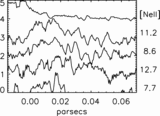Mid-Infrared Emission at Photodissociation Regions in the Orion Nebula
Abstract
The mid-infrared emission from a photodissociation region (PDR) viewed edge-on in the Orion Nebula is examined through 8.7-20.6 μm images and 8-13 μm spectra. The polycyclic aromatic hydrocarbon (PAH) emission is located between the edges of H II regions and layers of [C I] emission, agreeing with PDR theory. Using a simple model, the spatial variations in the emission from PAHs detected at 8.6, 11.2, and 12.7 μm are demonstrated to be directly proportional to the material column density and the intensity of the UV field. For a homogeneous, neutral cloud illuminated by a bright OB star, PDR theory predicts that the ultraviolet (UV) radiation is attenuated exponentially (e-1.8Av). The predicted UV attenuation is confirmed by observations of broad PAH emission features found at 8.6, 11.2, and 12.7 μm. The PAH emission is found in cool regions having greater optical depths relative to regions where mid-infrared emission from ionized gas is observed. Through modeling we determine a gas density of 9.7×104 cm-3. On large and small size scales, the relative strengths of the 8.6, 11.2, and 12.7 μm PAH features at the bar of the Orion Nebula indicate that there is not a simple transition from ionized to neutral PAHs across the PDR.
- Publication:
-
The Astrophysical Journal
- Pub Date:
- February 2006
- DOI:
- Bibcode:
- 2006ApJ...637..823K
- Keywords:
-
- ISM: Dust;
- Extinction;
- ISM: H II Regions;
- Infrared: ISM;
- ISM: Individual: Name: Orion Nebula
